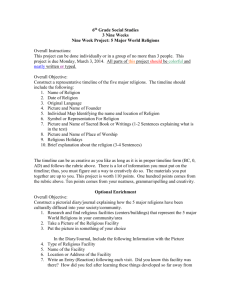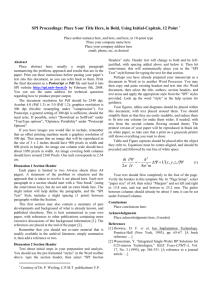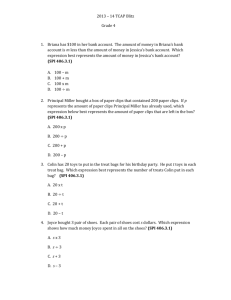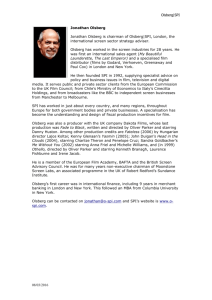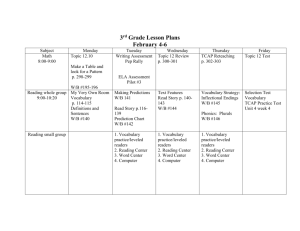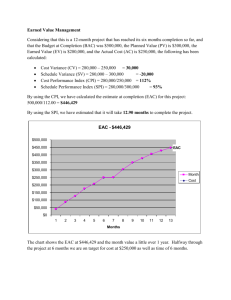Mesopotamia: Safari Montage-Ancient - MNPS2010
advertisement
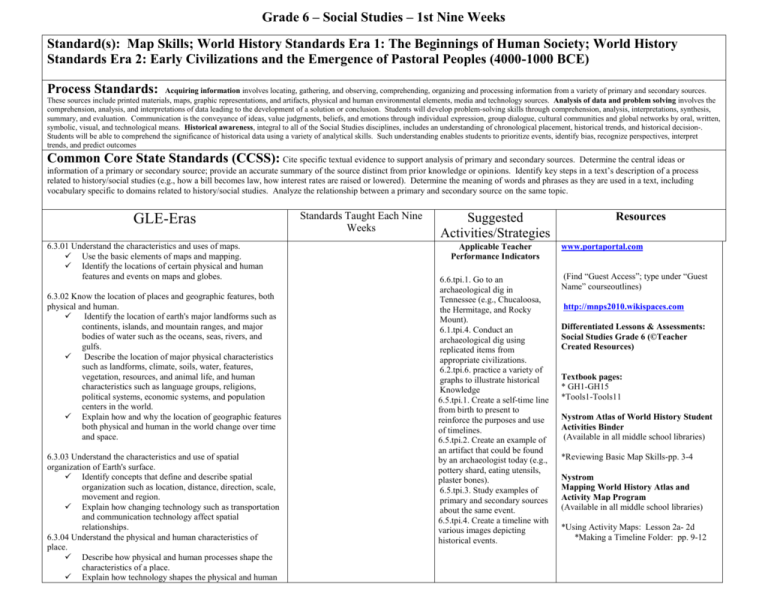
Grade 6 – Social Studies – 1st Nine Weeks Standard(s): Map Skills; World History Standards Era 1: The Beginnings of Human Society; World History Standards Era 2: Early Civilizations and the Emergence of Pastoral Peoples (4000-1000 BCE) Process Standards: Acquiring information involves locating, gathering, and observing, comprehending, organizing and processing information from a variety of primary and secondary sources. These sources include printed materials, maps, graphic representations, and artifacts, physical and human environmental elements, media and technology sources. Analysis of data and problem solving involves the comprehension, analysis, and interpretations of data leading to the development of a solution or conclusion. Students will develop problem-solving skills through comprehension, analysis, interpretations, synthesis, summary, and evaluation. Communication is the conveyance of ideas, value judgments, beliefs, and emotions through individual expression, group dialogue, cultural communities and global networks by oral, written, symbolic, visual, and technological means. Historical awareness, integral to all of the Social Studies disciplines, includes an understanding of chronological placement, historical trends, and historical decision-. Students will be able to comprehend the significance of historical data using a variety of analytical skills. Such understanding enables students to prioritize events, identify bias, recognize perspectives, interpret trends, and predict outcomes Common Core State Standards (CCSS): Cite specific textual evidence to support analysis of primary and secondary sources. Determine the central ideas or information of a primary or secondary source; provide an accurate summary of the source distinct from prior knowledge or opinions. Identify key steps in a text’s description of a process related to history/social studies (e.g., how a bill becomes law, how interest rates are raised or lowered). Determine the meaning of words and phrases as they are used in a text, including vocabulary specific to domains related to history/social studies. Analyze the relationship between a primary and secondary source on the same topic. GLE-Eras 6.3.01 Understand the characteristics and uses of maps. Use the basic elements of maps and mapping. Identify the locations of certain physical and human features and events on maps and globes. 6.3.02 Know the location of places and geographic features, both physical and human. Identify the location of earth's major landforms such as continents, islands, and mountain ranges, and major bodies of water such as the oceans, seas, rivers, and gulfs. Describe the location of major physical characteristics such as landforms, climate, soils, water, features, vegetation, resources, and animal life, and human characteristics such as language groups, religions, political systems, economic systems, and population centers in the world. Explain how and why the location of geographic features both physical and human in the world change over time and space. 6.3.03 Understand the characteristics and use of spatial organization of Earth's surface. Identify concepts that define and describe spatial organization such as location, distance, direction, scale, movement and region. Explain how changing technology such as transportation and communication technology affect spatial relationships. 6.3.04 Understand the physical and human characteristics of place. Describe how physical and human processes shape the characteristics of a place. Explain how technology shapes the physical and human Standards Taught Each Nine Weeks Suggested Activities/Strategies Applicable Teacher Performance Indicators 6.6.tpi.1. Go to an archaeological dig in Tennessee (e.g., Chucaloosa, the Hermitage, and Rocky Mount). 6.1.tpi.4. Conduct an archaeological dig using replicated items from appropriate civilizations. 6.2.tpi.6. practice a variety of graphs to illustrate historical Knowledge 6.5.tpi.1. Create a self-time line from birth to present to reinforce the purposes and use of timelines. 6.5.tpi.2. Create an example of an artifact that could be found by an archaeologist today (e.g., pottery shard, eating utensils, plaster bones). 6.5.tpi.3. Study examples of primary and secondary sources about the same event. 6.5.tpi.4. Create a timeline with various images depicting historical events. Resources www.portaportal.com (Find “Guest Access”; type under “Guest Name” courseoutlines) http://mnps2010.wikispaces.com Differentiated Lessons & Assessments: Social Studies Grade 6 (©Teacher Created Resources) Textbook pages: * GH1-GH15 *Tools1-Tools11 Nystrom Atlas of World History Student Activities Binder (Available in all middle school libraries) *Reviewing Basic Map Skills-pp. 3-4 Nystrom Mapping World History Atlas and Activity Map Program (Available in all middle school libraries) *Using Activity Maps: Lesson 2a- 2d *Making a Timeline Folder: pp. 9-12 Grade 6 – Social Studies – 1st Nine Weeks characteristics of places. Activities In groups, have students create a world map to scale labeling continents, oceans, lines of latitude and longitude, map key, and compass rose on poster paper or on paper plates. Explain why places have specific physical and human characteristics in different parts of the world. 6.3.spi.1 Identify the basic components of a world map (i.e., compass rose, map key, scale, latitude and longitude lines, continents, oceans). 6.3.spi.2 Identify basic geographic forms (i.e., rivers, lakes, bays, oceans, mountains, plateaus, deserts, plains, coastal plains). 6.3.spi.5. Use a variety of maps to understand geographic and historical information (i.e., political maps, resource maps, product maps, physical maps, climate maps, vegetation maps). 6.3.spi.6. Interpret a graph that illustrates a major trend in world history (i.e. population growth, economic development, governance land areas, growth of religions). Have students create a chronological timeline including at least ten events from their personal history. The teacher will break an ordinary object (i.e. a coffee cup) and bury it in dirt within a small box. In groups have students “excavate” the pieces and assemble them appropriately. 6.5.03 Identify how to use historical information acquired from a variety of sources. Explain how geologists, archaeologists, and anthropologists study early human development. 6.1.spi.2. Identify the job characteristics of archaeologists, anthropologists, geologists, and historians. 6.5.17 Identify how to use historical information acquired from a variety of source 6.5.spi.1 Read a timeline and order events of the past between prehistory and the Renaissance. 6.5.spi.6. Recognize the designations for time dating (i.e., BCE, AD, centuries, decades, prehistoric, historic.) Have students create a timeline which encompasses the length of the classroom. As the year progresses, students will add dates of the civilizations they are learning about. CCSS: Begin research for participation in National History Day. World History Standards Era 1: The Beginnings of Human Society Early Man www.nationalhistoryday.org History 6.5.01 Recognize the importance of fire, weapons, and tools to early cultures and agriculture. List ancient weapons and tools. Understand the role of the environment in terms of influencing the development of weapons, and tools. Explain the role of agriculture in early settled www.tennesseehistory.org/historyday.htm Culture 6.1.01 Understand the nature and complexity of culture. Define the basic components of culture. Grade 6 – Social Studies – 1st Nine Weeks communities. Recognize the immediate and long term impacts and influences of early agricultural communities such as Southwest Asia and the African Nile Valley. 6.5.02 Understand the place of historical events in the context of past, present and future. Describe the biological processes that shaped the earliest human communities. Identify the characteristics of hunter-gatherer communities in various continental regions in Africa versus the Americas. Explain how different early human communities expressed their beliefs. .Identify scientific evidence regarding early human settlements in Africa. 6.5.spi.2. Recognize the types of early communities (i.e., nomadic, fishing, farming). 6.5.spi.5. Identify major technological advances (i.e., tools, wheel, irrigation). 6.5.spi.7. Recognize major historical time periods (i.e., Early Civilizations . Culture 6.1.spi.1 Recognize the basic components of culture (i.e., language, common values, traditions, government, art, literature, lifestyles). Economy 6.2.spi.3. Identify disadvantages and advantages of nomadic and early farming lifestyles (i.e., shelter, food supply, and, domestication of plants and animals). Geography Governance and Civics 6.4.spi.2. Recognize the steps that give rise to complex governmental organizations (i.e., nomadic, farming, village, city, city-states, and states). ______________________________________________________ World History Standards Era 2: Early Civilizations and the Emergence of Pastoral Peoples (4000-1000 BCE) Mesopotamia, Egypt, and the Israelites History 6.5.04 Recognize the importance of agriculture, evolution of writing, education, law, and trade in the development of early civilizations. Describe the characteristics of writing in Mesopotamia, Egypt, and the Indus valley and how their written records shaped political, legal, religious, and cultural life. 6.5.05 Understand the place of historical events in the context of Identify how communities reflect the cultural background of their inhabitants. Compare how cultures differ in their use of similar environments and resources. Analyze how human migration and cultural activities influence the character of a place. 6.1.02 Recognize the role of major religions. Define religion. Describe the beliefs of the world major religions. Identify the founders of the world's major religions. 6.1.03 Appreciate the relationship between physical environments and culture. Identify characteristics of a physical environment that contribute to the growth and development of a culture. Evaluate the effect of technology on a culture. Explain why individuals and groups respond differently to their physical and social environments. 6.1.04 Recognize how cultural and individual's perceptions affect places and regions. Explain how information and experiences may be interpreted differently from people of diverse cultural perspectives and frames of reference. Describe instances in which language, art, music, belief systems, and other cultural elements can facilitate understanding or cause misunderstanding. 6.1.05 Understand the role that diverse cultures and historical experiences had on the development of the world. Explain and give examples of how language, literature, the arts, architecture, other artifacts, traditions, beliefs, Applicable Teacher Performance Indicators Textbook Chapter-Sections: 6.2.tpi.4. Create a comparison chart between nomadic life and farming life. 6.1.tpi.9. Participate in a threegroup rotation with a barter market, cuneiform writing, and map skill using reading for information worksheet about a society. 6.1.tpi.11. Analyze how communities kept track of and regarded the passage of time. 6.2.tpi.7. Predict the items and their economic cost of an average household in different geographic areas throughout historical time periods. 6.3.tpi.2. Research various methods of farming exhibited by various communities. 6.3.tpi.10. Write a fictional account describing a historical community's physical geography choosing from a contemporary community that history changed dramatically through human or natural consequences (e.g., , desertification, irrigation). 6.2.tpi.10. Judge the relative economic and psychological costs for a community when it commits to a grand scale project. 6.5.tpi.1. Create a self-time line from birth to present to reinforce the purposes and use of timelines. 6.5.tpi.2. Create an example of an artifact that could be found by an archaeologist today (e.g., pottery shard, eating utensils, plaster bones). 6.5.tpi.3. Make a facsimile Rosetta Stone (e.g., compare English, a student created language, and cuneiform or Early Man 1-1, 1-2, 1-3 Nystrom Atlas of World History Student Activities Binder *People Migrate Across the Earth- pp. 7-8 *Agriculture and Early Settlements-pp. 9-10 Nystrom Mapping World History Atlas and Activity Map Program *Agriculture and Settlements-pp. 19-22 Early Man: Safari Montage-Walking With Cavemen: Blood Brothers- Episode Two Textbook Chapter-Sections: Mesopotamia 1-1, 1-2 Grade 6 – Social Studies – 1st Nine Weeks past, present and future. Compare and contrast how the economic, political, cultural, and environmental factors among the ancient civilizations of Egypt, Indus River Valley, China, and Mesopotamia shaped their histories. Identify significant individuals and events in Egyptian civilization. Identify early forms of writing, law, and trade i.e. cuneiform, hieroglyphics, barter, Code of Hammurabi, and the Ten Commandments. 6.5.spi.1 Read a timeline and order events of the past between prehistory and the Renaissance. 6.5.spi.3. Identify types of artifacts by pictorial representation (i.e., Egyptian). 6.5.spi.4. Recognize the forms of early world writing (i.e., cuneiform and Egyptian/Native American Hieroglyphics). 6.5.spi.5. Identify major technological advances (i.e., tools, wheel, irrigation, river dikes, development of farming, advances in weaponry, written language). 6.5.spi.11. Identify characteristics including economy, social relations, religion, and political authority of various societies (i.e., Mesopotamian, Egyptian). 6.5.spi.12. Recognize the possible causes of change in civilizations (i.e., environmental change, political collapse, new ideas, warfare, overpopulation, unreliable food sources, and diseases). 6.5.spi.16. Compare and contrast the historical development of the Western, Eastern, and African cultures. 6.5.spi.17. Recognize the significant mythologies of the Sumerians and Egyptians. 6.5.08 Understand the place of historical events in the context of past, present, and future. Identify the characteristics of the Assyrian and Babylonian Empires. 6.5.09 Identify how to use historical information acquired from a variety of sources. Compare geographical and architectural features of Egypt. Culture 6.1.spi.1 Recognize the basic components of culture (i.e., language, common values, traditions, government, art, literature, lifestyles). 6.1.spi.3. Recognize the world's major religions and their founders (i.e., Judaism, Moses). 6.1.spi.5. Identify differences between various cultural groups (i.e., European, Eurasian, Indian, Southeast Asian, Middle Eastern, African, Native American). 6.1.spi.6. Recognize reasons that cultural groups develop or settle in specific physical environments. 6.1.spi.7. Identify how early writing forms in values, and behaviors contribute to the development and transmission of culture. Define cultural diffusion. Compare different ways in which cultural diffusion takes place. 6.1.06 Understand the influence of science and technology on the development of culture through time. Construct a time line of technological innovations and rate the importance of technological advancements. Show through specific examples how science and technology have changed people's perceptions of the social and natural world. Describe examples in which values, beliefs, and attitudes have been influenced by technological knowledge. Economics 6.2.01 Understand fundamental economic concepts and their application to a variety of economic systems. Explain the relationship of supply and demand in early World History. Describe the change from hunter/gatherer economies to economies based on animal and plant domestication. Investigate the impact of trade on the economies of early civilizations. 6.2.02 Discuss economic connections, conflicts, and interdependence. Define various types of economies and their methods of production and consumption. Apply economic concepts to evaluate historic developments. Explain the economic impact of improved communication and transportation. hieroglyphics). 6.1.tpi.1. Recognize the variety of cultures within a community by comparison. 6.1.tpi.2. Make and sample foods from a cultural region. 6.1.tpi.3. write and decipher messages using various alphabets 6.2.tpi.1. Trace the path of an produced item. (e.g. clothing, consumer goods, foods) to the classroom. 6.2.tpi.2. Discuss how a society's economics are affected by the geography of the community. 6.4.tpi.4. Write a set of laws for the classroom. Compare these laws to various historical codes. (e.g. Hammurabi's Code, Ten Commandments). 6.5.tpi.3. Make a facsimile Rosetta Stone (e.g., compare English, a student created language, and cuneiform or hieroglyphics). 6.3.tpi.3. Determine how the environment affected the development of a community. 6.3.tpi.8. Decide where to settle a hypothetical community on a geographic map. Activities The teacher will place butcher paper on the walls along the bottom of the classroom. Have students use poster paints to create “cave paintings’ along the classroom walls. Place students in three groups: hunter-gatherer, early farmer, and fisherman. Allow them to do computer research on their assigned group. When they finish the students will create a skit Primary Sources Library-Textbook p. 738 “ Epic of Gilgamesh” Mesopotamia: Safari Montage-Ancient Mesopotamia Nystrom Atlas of World History Student Activities Binder *Civilization in Ancient Mesopotamia-pp. 11-12 *Babylonia and Assyria-pp. 13-14 Nystrom Mapping World History Atlas and Activity Map Program *Mesopotamian Empires-pp. 23-26 *Phoenician Trade-pp. 31-34 Textbook Chapter-Sections: Egypt 2-1, 2-2, 2-3 Primary Sources Library-Textbook p. 739 “An Egyptian Father’s Advice to His Son” Egypt: Safari Montage-Horrible Histories: Awesome Egyptians Nystrom Atlas of World History Student Activities Binder *Civilizations in Ancient Egypt-pp. 17-18 Nystrom Mapping World History Atlas and Activity Map Program *Ancient Egypt and the Nile-pp. 43-46 *A Mighty Pharaoh-pp. 47-50 Textbook Chapter-Sections: Israelites Chapter 3-all Primary Sources Library-Textbook p. 739 “Ancient Israelites” Grade 6 – Social Studies – 1st Nine Weeks Mesopotamia, Egypt, and the Indus Valley influenced life (i.e., legal, religious, and culture). 6.1.spi.8. Recognize how migration and cultural diffusion influenced the character of world societies (i.e., spread of religions, empire building, exploration, languages). Economy 6.2.spi.1. Recognize an example of a barter economy. 6.2.spi.4. Recognize the importance of economic systems in the development of early civilizations around rivers (i.e., Tigris and Euphrates, Nile). 6.2.spi.6. Analyze how basic economic ideas influenced world events (i.e., supply and demand leads to exploration and colonization). Geography 6.3.spi.3. Identify the location of early civilizations on a map (i.e. Mesopotamian, Egyptian). 6.3.spi.4 Identify geographic reasons for the location of population centers prior to 1500 (i.e. coastal plains, deserts, mountains, river valleys). Governance and Civics 6.4.spi.1 Recognize types of government (i.e. formal/informal, monarchy, theocracy). 6.4.spi.2. Recognize the steps that give rise to complex governmental organizations (i.e., nomadic, farming, village, city, city-states, and states). 6.4.spi.3. Identify the development of written laws (i.e., Hammurabi’s Code). 6.4.spi.4. Recognize the roles assigned to individuals in various societies (i.e., city-state systems, class systems). 6.4.spi.5. Compare and contrast the lives of individual citizens in various governmental organizations (i.e. monarchial systems,). Individuals, Groups and Interactions 6.6.spi.2. Recognize the impact of individuals on world history (i.e., Ramses II). Appraise the relationship among scarcity of resources, economic development, and international conflict. 6.2.03 Understand the potential costs and benefits of individual economic choices. Differentiate between needs and wants. Analyze how supply and demand, and change in technologies impact the cost for goods and services. Evaluate the relationship between creditors and debtors. Governance and Civics 6.4.01 Explain the development of a people's need to belong and organize into a system of governance. Identify informal and formal forms of governance. Describe the purpose of governance and how its powers are acquired, used and justified. Analyze the necessity of establishing and enforcing the rule of law. Originate models of lower to higher forms of social and political orders. 6.4.02 Describe the purposes and structure of governments. Identify written laws handed down from ancient civilizations. Explore the development of citizenship and government in ancient civilizations. Explain and apply concepts such as power, role, status, justice and influence to the examination of persistent issues and social problems. Recognize the relationship between a place's physical, political, and cultural characteristics and the type of government that emerges in that place. 6.4.03 Identify how cooperation and conflict among people influence the division and control resources, or a paper to present their findings. Teach students the Common Threads of social studies: art/architecture, religion, writing system, government, innovations, citizenship, geography, and economy. At the end of study of each civilization, have students identify specifics for each of the common threads. Students should also keep a map of the world for the entire year. As a civilization is completed, students should map the location as a review. Instruct students to create handmade goods (i.e. bracelet, brownies, and origami). On a designated day, students should bring their goods to school to conduct a trade/barter fair. Students then write an essay to discuss the pros and cons of a barter economy versus a money economy. Using red clay purchased at Michael’s (approximately $5.99) and a toothpick, allow students to create a medallion using cuneiform writing Israelites: Safari Montage-What Is Judaism? Nystrom Atlas of World History Student Activities Binder *Hebrew Kingdoms-pp. 15-16 Nystrom Mapping World History Atlas and Activity Map Program *Hebrew Migration-pp. 27-30 Grade 6 – Social Studies – 1st Nine Weeks rights, and privileges. Identify natural resources that are necessary to the survival of a civilization. Differentiate between rights and privileges of the individual. Consider how cooperation and conflict affects the dissemination of resources, rights and privileges. Individuals, Groups and Interactions 6.6.01 Understand the impact of individual and group decisions on citizens and communities. Recognize that individuals can belong to groups but still have their own identity. Relate personal changes to social, cultural, and historical contexts. Describe personal connections to place, as associated with community, nation and world. Describe ways regional, ethnic, and national cultures influence individuals' daily lives. 6.6.02 Understand how groups can impact change at world levels. Identify and describe ways family, groups, and community influence the individual's daily life and personal choices. Demonstrate an understanding of concepts such as role, status, and social class in describing the interactions of individuals and social groups. Analyze group and institutional influences on people, events, and elements of culture Grade 6 – Social Studies – 1st Nine Weeks Suggested Integrated Activities Science: Research the biome of the Fertile Crescent. Math: Measuring Distance with a Map Scale: Pick two cities on a map. Measure the distance between the two locations. Calculate the distance according to the map scale. Calculating Length of a Timeline: Prepare a timeline of world history covering everything from the time humans first left Africa to the present- draw to scale. Calculate how long the timeline will be if each century is one inch long. Comparing Lengths of Foreign Rule: Using a timeline from the Nystrom atlas, calculate the number of years each foreign empire ruled Egypt. Make a Bar Graph showing the length of each rule. Understanding B.C. and A.D.: Draw a timeline and label its two directions B.C. and A.D. Plot dates from the unit on the number line and calculate the years between B.C. and A.D. dates. Reading: Create an outline of Early Humans (Chapter 1, section1). Fill in details of the outline from the illustrations, drawings, and captions in the chapter. Create a Venn diagram of the Paleolithic and Neolithic times. Have students write an article describing the invention of tools by people in Paleolithic times. Tell then to write the article as if they were magazine writers visiting an archaeological site. Language Arts: Have students research information about The Epic of Gilgamesh. Then have them write a short paragraph describing its importance. Science/Math/Language Arts: . In science, students will gather data about a particular topic of interest. In math, students will take the collected data and create a table, bar graph, line graph etc. In language arts, the students will write a paragraph explaining their data tables.

